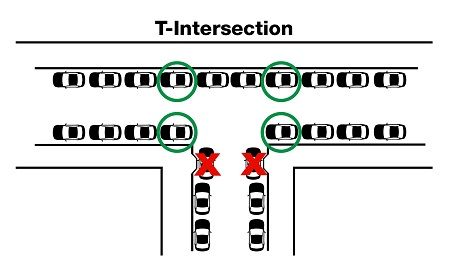Gentile Defends Parking Rule Change Following Critic’s Claim That It Makes Streets Less Safe

Streetsblog managing editor Brad Aaron wrote a post last week claiming that a Department of Transportation rule change fought for by Councilman Vincent Gentile is making streets less safe, but the councilman is standing by the decision.
The rule in question was adopted in 2009, allowing drivers to park at T intersections, and making it legal to block crosswalks where there are no traffic signals, painted lines or stop signs.
In addition to creating more parking spaces, Gentile argued at the time that it made the streets safer for pedestrians, since there were no indications to drivers that a crosswalk was there and thus no reason to slow down.
But according to Aaron, the unmarked crosswalks are statistically safer, and by allowing cars to block them off the city is pushing pedestrians to more dangerous crosswalks.
[A]ccording to an NYU Langone Medical Center study of Bellevue trauma patients, more pedestrians are injured while crossing in crosswalks with “walk” signals than while crossing mid-block or against the signal. Data mapped by Transportation Alternatives’ CrashStat show that, between 1995 and 2009, there were no pedestrian-involved crashes at Seaman and Payson, while the two closest signalized intersections saw a handful of injury crashes each.
Has blocking unmarked crosswalks — which are natural walking paths — stopped people from using them? No, but it has worsened sight lines, making it harder for drivers and pedestrians to see each other. What the city should be doing is daylighting space next to pedestrian curb ramps — the opposite of the Gentile rule.
The data cited appears to suggest that unmarked crosswalks or crossing in the middle of the street is safer, but a closer look at the source material seems to upend that. The data was pulled from 1,400 pedestrians and cyclists treated at Bellevue for collisions between 2008 and 2011. As the New York Times reported:
Of those injured on the street, 44 percent used a crosswalk, with the signal, compared with 23 percent who crossed midblock and 9 percent who crossed against the signal.
But the research makes no correlation, and seems to only suggest that pedestrian-related accidents happen where pedestrians are more likely to be – ie. marked crosswalks with a signal. It does not suggest that crossing mid-block is safer, just that less people were treated for injuries sustained doing so – which makes sense since fewer people are likely to do that in the “busiest corridors” in Manhattan and western Brooklyn, where most of the patients were injured.
Aaron didn’t turn to Gentile for a response, so we did.
Back in 2008, Department of Transportation engineers took a long hard look at unregulated “T” intersections. Even though these areas had been outfitted with pedestrian ramps, there was no denying their dangerous design due to the lack of marked crosswalks, signals, signage or other traffic control devices. In addition, inadequate sight distances made these intersections extremely unsafe, especially for the disabled. As a result of these findings, the Dept. of Transportation amended the rules which also allowed for drivers to park in these newly redefined areas. Since then, I have done my best to promote and publicize the existence of this obscure rule change because it first and foremost helps keeps pedestrians safe and creates a few more parking spots in the process. I continue to work closely with the Dept. of Transportation towards making our streets a safe place where pedestrians, cyclists and drivers can all co-exist responsibly.




